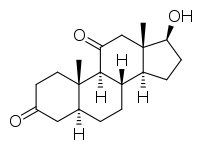11-Ketodihydrotestosterone
 | |
| Names | |
|---|---|
| IUPAC name
(5S,8S,9S,10S,13S,14S,17S)-17-Hydroxy-10,13-dimethyl-2,4,5,6,7,8,9,12,14,15,16,17-dodecahydro-1H-cyclopenta[a]phenanthrene-3,11-dione | |
| Other names
11-Oxodihydrotestosterone; 5α-Androstan-17β-ol-3,11-dione; 11-KDHT | |
| Identifiers | |
| 3D model (JSmol) |
|
| ChemSpider | |
| PubChem CID |
|
| |
| |
| Properties | |
| C19H28O3 | |
| Molar mass | 304.43 g/mol |
| Except where otherwise noted, data are given for materials in their standard state (at 25 °C [77 °F], 100 kPa). | |
| Infobox references | |
11-Ketodihydrotestosterone (11-KDHT), also known as 5α-androstan-17β-ol-3,11-dione, is an endogenous, naturally occurring steroid and androgen prohormone that is produced primarily, if not exclusively, in the adrenal glands.[1] It is closely related to 11β-hydroxyandrostenedione (11β-KA4), adrenosterone (11-ketoandrostenedione; 11-KA4), and 11-ketotestosterone (11-KT), which are also produced in the adrenal glands.[1]
See also
References
This article is issued from
Wikipedia.
The text is licensed under Creative Commons - Attribution - Sharealike.
Additional terms may apply for the media files.